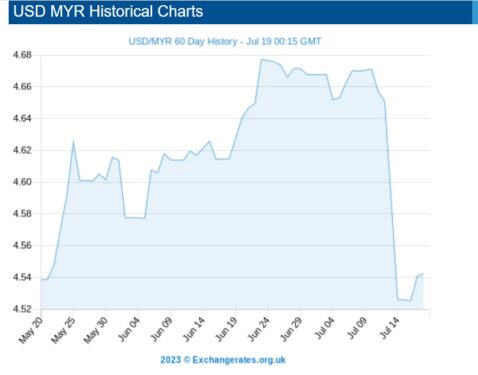THE Malaysian ringgit is undergoing a transition period of weakening pace against the US dollar, the world’s dominant currency for trade and financial settlement.
The faster pace of the US Federal Reserve’s tightening monetary policy starting in March 2022 had caused a strong appreciation of the greenback which directly suppressed emerging markets’ currencies, including the ringgit.
In our view, the ringgit exchange rate overshooting does not reflect the nation’s underlying economic and financial fundamentals:
- Positive initial economic conditions: The Malaysian economy ended the year 2022 with a strong economic growth of 8.9% and registered a 5.6% in 1Q 2023.
Amid concerns about the global economy, we expect the domestic economy to continue growing albeit at a moderate pace in recent months due to falling exports. Growth in domestic demand will continue to normalise, thus holding up the economy.
- Keeping inflation at bay: Headline inflation has been easing steadily to 2.8% in May from 4.7% in August 2022. However, core inflation remains persistent. Labour market conditions remain stable with unemployment rate steadying at 3.5% in May 2023.
- Still running comfortable trade and current account surplus (albeit narrowing): The current account surplus is projected to range between 2.0-3.0% of gross domestic product (GDP) in 2023 (2.6% of GDP in 2022).
Net foreign direct investment (FDI) inflows have expanded higher to RM74.6 bil in 2022 and RM50.4 bil in 2021 compared to RM13.2 bil in 2020. In 1Q 2023, net FDI inflows amounted to RM12.0 bil. 1Q 2023 also saw higher approved investment projects of RM71.4 bil with an average of RM288.6 bil per year in 2021-2022.

- Well-capitalised banking system: This shall bolster the bank’s capacity to support lending activity and absorb unexpected losses.
The banking system’s total capital ratio remained strong at 18.8% in December 2022 with capital buffers of RM134.8 bil in excess of the regulatory minimum. Domestic capital market is deep and efficient to mitigate the impact of capital-flow volatility.
Malaysia’s participation in regional and global international financial adds another layer of buffer against foreign currency liquidity crisis.
- Sustainability of reserves accumulation is important: Malaysia’s outstanding foreign reserves stood at US$111.4 bil as of end-June 2023 which was able to cover 5.0 months of retained imports and 1.0x of short-term debt.
Excluding forwards position of foreign currencies of US$23.7 bil in May, foreign reserves remain comfortable at US$87.7 bil.
- Commitment towards budget consolidation: Additionally, the government must re-build fiscal space through revenue enhancement, expenditure rationalisation and restraint as well as debt containment under the Medium-Term Fiscal Framework (MTFF).
The budget deficit is estimated to reduce to 5.0% of GDP in 2023 from 5.6% in 2022 and further to 4.1% of GDP in 2024 and 3.2% of GDP in 2025 on an assumption of about 5% GDP growth per annum for a five-year period.
Resilience against external shocks crucial
Experience has shown that Bank Negara Malaysia (BNM) was capable to mitigate the ringgit volatility, maintaining orderly market functioning and reducing any destabilising effects on the real economy.
We have been able to withstand the ringgit’s volatility reasonably well though there will be transitory impact of the weakening ringgit on households and businesses in the form higher imported inflation and imported raw materials respectively. The cost of servicing foreign currencies denominated borrowings will increase.
Malaysia has experienced several episodes of large and volatile capital flow reversals which had impacted on the international reserves and ringgit.

The 2008-2009 Global Financial Crisis (GFC) saw portfolio outflows of US$26.0 bil from the 3Q 2008 to 1Q 2009 period which led to the ringgit depreciating by 28.0% while the 2014-2015 oil price shock saw portfolio outflows which amounted to US$13.7 bil between 3Q 2014 and 3Q 2015.
Since 2015 when the US Federal Reserve had increased its policy rate nine times by 225 basis points, the ringgit depreciated by about 50% from RM2.9675 per/US$1 in May 2013 to the trough of RM4.499/US$1 in January 2017.
Since the US Fed began its aggressive rate hikes cycle in March 2022 to fight soaring inflation, the ringgit swung as much as 11.5% between end-March and early November before appreciating towards the year end. For the period March 2022 till end-June 2023, the ringgit had depreciated by 10.2% against the greenback.
While the US dollar index is now weakening as easing inflation strengthens the case for the US Fed to pause its rate-hike campaign in the coming months, there are arguments in favour for renewed strength in the US dollar which include the Fed keeping rates higher for longer if inflation does not fall back within its target while global risk aversion may prompt investors to seek shelter in the greenback.
The strength of the ringgit will depend on how well Malaysia sustain its economic growth in an environment of price and financial stability; mend the budget deficit and contain debt and liabilities; rebuild both domestic and foreign investors’ confidence; revitalise domestic investment; and attract the inflows of dependable long-term FDI as well as make domestic equities market appealing to portfolio investors.
We must continue to focus on strengthening economic resilience against external shocks through stronger fundamentals by pursuing structural reforms to keep the Malaysian economy sustainable competitive and support the ringgit. – July 19, 2023
Lee Heng Guie is the executive director at Socio-Economic Research Centre (SERC) Malaysia.
The views expressed are solely of the author and do not necessarily reflect those of Focus Malaysia.
Main pic credit: Capital Post









